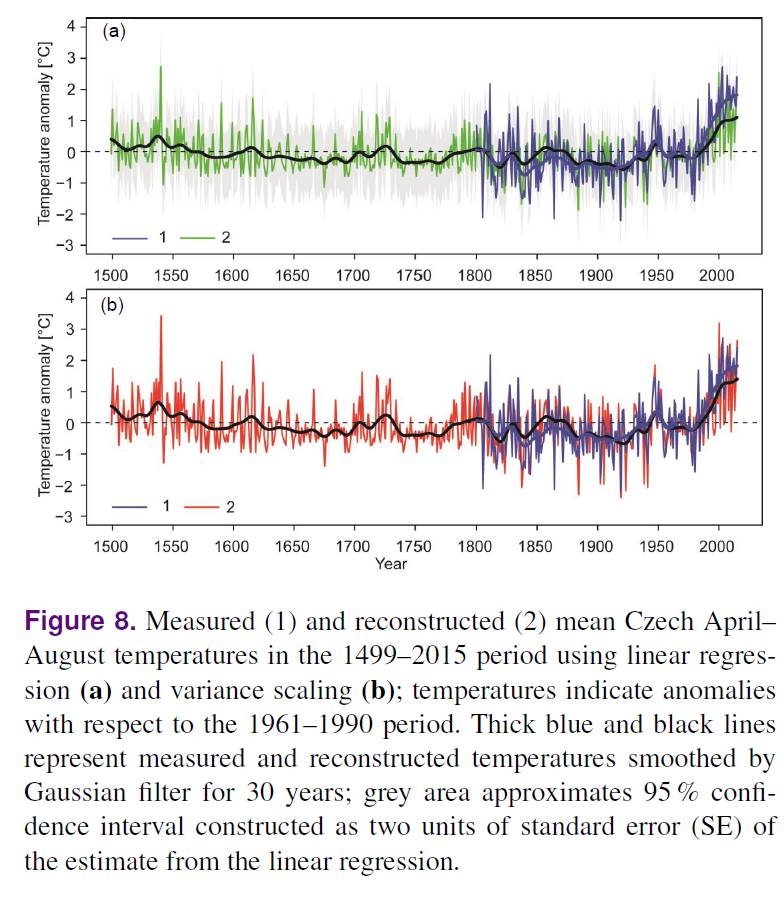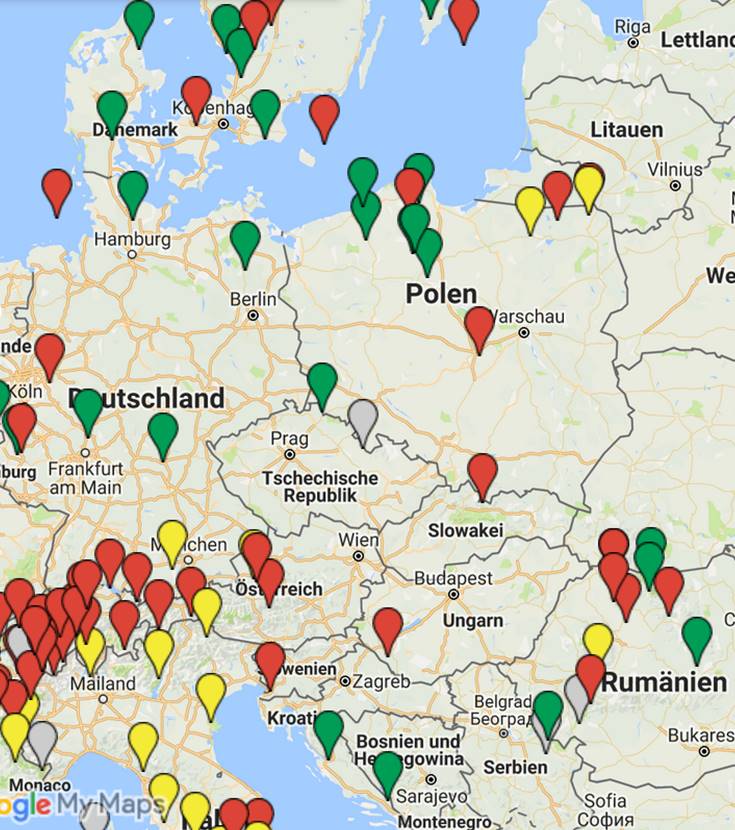Imagine the hysteria we would see from the establishment if the following happened today. Our modern technical life probably would get banned by hysterical politicians and environmentalists. Just how bad that summer was is described here in detail. More below:
======================================
Top summer in the Czech Republic: Unexpected heat in 1540
By Dr. Sebastian Lüning and Prof. Fritz Vahrenholt
(German text translated/edited by P Gosselin)
Temperature measurements as a rule go back one or two hundred years. Thus beyond the thermometer age, one has to work with so-called proxies. In the Czech epublic one team of scientists led by Martin Možný reconstructed the temperature history of the country using the historical data on grape harvests going back 500 years. (Figure 1).
 Figure 1: Temperature of the Czech Republic over the past 500 years. From Možný et al. 2016. The blue curve since 1800 AD represents thermometer data.
Figure 1: Temperature of the Czech Republic over the past 500 years. From Možný et al. 2016. The blue curve since 1800 AD represents thermometer data.
The harvest time turned out to be a reliable indicator of the April to August temperature. As expected, the warmest 30-year interval occurred from 1986-2015. Interestingly, however, 1540 was identified as the hottest of the last 500 years and was part of an above average period in the 16th century.
What follows is the Abstract of the Paper in the journal Climate of the Past:
April–August temperatures in the Czech Lands, 1499–2015, reconstructed from grape-harvest dates
Viticulture has long been essential to the commercial and social well-being of parts of the Czech Lands (now the Czech Republic), and detailed records have been kept for centuries of the timing and relative success of the grape crop. Using such documentary data from the Bohemian wine-growing region (mainly northwest of the capital, Prague), series of grape-harvest dates (GHDs) were created for the 1499–2015 period. Because the link between harvest dates and temperatures is strong, GHD series, together with instrumental mean temperature series starting in 1801, were used to reconstruct mean April–August temperatures for the region from 1499 to 2015. Linear regression (LR) and variance scaling (VS) methods were used for calibration and compared in terms of explained variance and their ability to capture extreme values. It emerged that LR does not significantly underestimate temperature variability. However, VS shows far greater capacity to capture extremes. GHDs explain 64 % of temperature variability over the full calibration period. The 1986–2015 period was identified as the warmest 30-year period of the past 514 years, an observation consistent with recent global warming. The highest April–August temperatures appeared in a reconstruction for the year 1540, which was warmer than the next two very warm, and far more recent, seasons in 2003 and 2015. The coldest period occurred at the beginning of the 20th century (1900–1929). The series reconstructed for the Czech Lands is in close agreement with other (central) European reconstructions based on other proxies. The series created here makes an important contribution to a better understanding of long-term spatiotemporal temperature variability in central Europe.
It can be observed that the study’s period of investigation did not reach into the Medieval Warm Period (MWP). I t would have been interesting to have compared the the current warm period with the MWP. In general the data in the Czech Republic for the MWP is extremely scant.
Within the scope of the MWP charting project, not a single study has been found to date for this time period. Looking across regions, a warm MWP is highly likely when we look at the studies from neighboring countries (red points). From a hydro-climatological view, the Czech Republic borders on the humid northern European MWP (green points ) and the southern European dry MWP (yellow points).






Nice work, and time intensive. I have suggested that wine grapes would be a better proxy than trees for climate investigations. So, I am pleased to see that this has been done.
Because of the importance of the season’s weather to grape quality and (perhaps) wine quality the winegrowers have kept good records for many years.
Still, grape quality and harvest respond best to the most appropriate weather and not just the hottest temperatures. Too hot during the day is not good, likewise very warm nights. There isn’t good information of these things 400 or 500 years ago. This is an interesting study, nevertheless.
Going forward (just some info here): In hot areas of the USA growers use overhead misting systems to counter the heat. Now, many temperatures are reported from airports and such places, making the “official” temperature for a region very unlike what the grapes experience. Researchers have invested time and effort learning how to grow better grapes in both hot and cold climate zones.
During the Medieval Warm Period there were reports of grapes being grown in Scotland, Denmark, Sweden and North Germany. The varieties seem to have also been rather more tolerant of hot weather. Elbling, Rauchling, Argant, and Gouais and others, most now clinging to the Thermenregion in Austria and in the south of France. So it is no surprise that there were hot months further south in Europe.
It is recorded that on 2 occasions the importers of French wines into England complained about the Bishop of Durham not being taxed as they were even though his wines were selling at up to 3 times those from France. It does appear that the Bishop donated a hogshead to the King, and the importers weren’t above diluting their wine with cider made from red juiced apples.
Regarding “red juiced apples”
I’ll guess the apple juice was not colored, or not much. Rather a very dark skinned grape could have been used to get the “wine color.” What grape that was, I don’t know. Today, wines might be blended with Alicante Bouschet to get a darker color. Here’s a description:
http://www.winepros.org/wine101/grape_profiles/alicante.htm
One of the Malvasia family of grapes (Black Malvasia ?) could have been used because those are of ancient origin, unlike Alicante.
John F. Hultquist:
There was a specific reference to a red fleshed Apple grown in Somerset for the London wine trade. Variety lost in the 19th Century.
The practice was for bulk shipments into England in barrels that resulted in some spoilage, so a ‘freshening’ with cider enhanced the taste.
Dark coloured grapes are well known but most seem to date from the 19th. Century.
There are numerous red or pink flesh apples.
Pendragon apparently known in Wales since the 1200’s.
Devonshire Quarrenden 1677. Gladstone 1780.
Red Love and Clifford (Beetroot red flesh) are more modern. Possibly the best list is infourseasonscabinrental.com.
The photo of the Clifford Apple
http://www.fourseasonscabinrental.com/clifford2-thumbnail.jpg
… shows an apple with flesh stained by the skin or peel that has the color. I make pink/red apple sauce with Red Rome apples. Most grapes are neutral in color also, except those called teinturier.
Lots of cheap wine has other fruit juice in the recipe. Other fruit colors tend to fade or brown so those wines are usually consumed sooner, rather than later. Good grapes, glass bottles, and corks allowed wine to be kept, and aged.
The 1520’s, 1530’s and 1550’s were also considered warm according to several historical sources, among which the date of grape harvest in Burgundy.
http://www.cairn.info/revue-de-la-bibliotheque-nationale-de-france-2010-3-page-26.htm
DE BILT, the Netherlands – The heatwave of 2003……..and 1540
“While the 2003 heatwave might rate a distinct entry in the record books, it hardly is the most severe summer to ever strike the Netherlands. Modern Dutch man, with his continued quest to ‘seek the sun’, is quite capable of dealing with the solar onslaught. In fact, most people considered the Summer of 2003 to be quite pleasant.
Heatwaves in earlier days, not unlike other harsh weather phenomenons, were more intrusive, and often disastrous.
…..historical geographer and retired science teacher Jan Buisman, …has dedicated much of his life to recording, investigating and analysing extreme weather conditions.
According to Buisman’s recent findings, the year 1540 was one with an even more severe summer than was 2003. All over Europe, the heatwave lasted, off and on, for seven months, with parched fields and dried up rivers, such as the Rhine. People in Paris, France could walk on the river bed of the Seine without getting their feet wet.
Wildfires
In medieval times, such severe weather conditions often led to other disasters. Although the Summer of 2003 presumably led to the untimely death of some 15,000 people in France alone, death and disease in 1540 struck many countries even worse.
Drought caused famine, countless deaths from dysentery and other illnesses caused by lack of safe drinking water, and to large-scale starvation of farm animals. Another disaster usually associated with heatwaves and droughts was fire, often destroying entire villages or even towns such as Harderwijk in 1503. Wooden houses became tinderboxes, dry peat, forests and undergrowth ignited readily and led to massive wildfires.
http://www.godutch.com/newspaper/index.php?id=474
DE BILT, the Netherlands – The heatwave of 2003……..and 1540
“While the 2003 heatwave might rate a distinct entry in the record books, it hardly is the most severe summer to ever strike the Netherlands. Modern Dutch man, with his continued quest to ‘seek the sun’, is quite capable of dealing with the solar onslaught. In fact, most people considered the Summer of 2003 to be quite pleasant.
Heatwaves in earlier days, not unlike other harsh weather phenomenons, were more intrusive, and often disastrous.
…..historical geographer and retired science teacher Jan Buisman, …has dedicated much of his life to recording, investigating and analysing extreme weather conditions.
According to Buisman’s recent findings, the year 1540 was one with an even more severe summer than was 2003. All over Europe, the heatwave lasted, off and on, for seven months, with parched fields and dried up rivers, such as the Rhine. People in Paris, France could walk on the river bed of the Seine without getting their feet wet.
Wildfires
In medieval times, such severe weather conditions often led to other disasters. Although the Summer of 2003 presumably led to the untimely death of some 15,000 people in France alone, death and disease in 1540 struck many countries even worse.
Drought caused famine, countless deaths from dysentery and other illnesses caused by lack of safe drinking water, and to large-scale starvation of farm animals. Another disaster usually associated with heatwaves and droughts was fire, often destroying entire villages or even towns such as Harderwijk in 1503. Wooden houses became tinderboxes, dry peat, forests and undergrowth ignited readily and led to massive wildfires.
http://www.godutch.com/newspaper/index.php?id=474